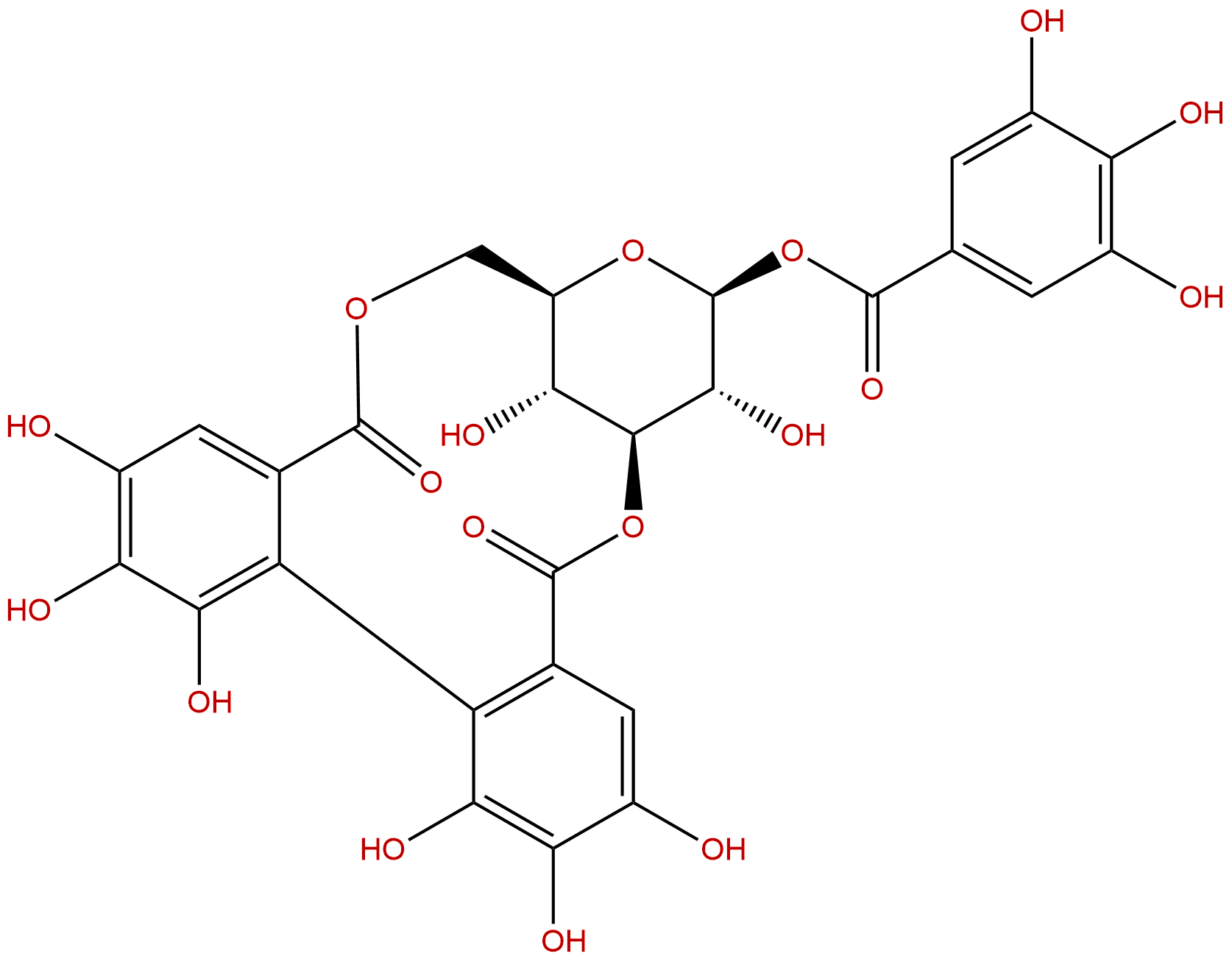
CorilaginCAS No.:23094-69-1 |
||||||||||
 |
|
|
||||||||

| Catalogue No.: | BP0393 |
| Formula: | C27H22O18 |
| Mol Weight: | 634.455 |
| Botanical Source: | Phyllanthus urinaria L. |
Product name: Corilagin
Synonym name:
Catalogue No.: BP0393
Cas No.: 23094-69-1
Formula: C27H22O18
Mol Weight: 634.455
Botanical Source: Phyllanthus urinaria L.
Physical Description:
Type of Compound: Phenols
Purity: 95%~99%
Analysis Method: HPLC-DAD or/and HPLC-ELSD
Identification Method: Mass, NMR
Packing: Brown vial or HDPE plastic bottle
Storage: Store in a well closed container, protected from air and light. Put into refrigerate or freeze for long term storage.
The product could be supplied from milligrams to grams
Inquire for bulk scale.
Description:
Corilagin has antitumour, anti-inflammatory, antioxidant, antifibrotics, antiviral, antibacterial, hepatoprotective, antiatherogenic, and antihypertensive activities. Corilagin reduces the cytotoxicity induced by EV71 or CA16 on Vero cells with and IC50 value of 5.6 and 32.33 μg/mL, respectively; it shows the potential to protect against HSV-1-induced encephalitis, and the beneficial effects may be mediated by inhibiting TLR2 signaling pathways. Corilagin attenuates bleomycin-induced epithelial injury and fibrosis via inactivation of oxidative stress, proinflammatory cytokine release and NF-κB and TGF-β1 signaling; it suppresses the activity of beta-lactamase to some extent.
References:
Phytother Res. 2014 May;28(5):781-3.
Sensitization of Hep3B hepatoma cells to cisplatin and doxorubicin by corilagin.
The anticancer action of gallotannins is a well-developed topic. We have demonstrated the in vivo antitumour activity of Corilagin on Hep3B hepatoma using the xenograft athymic nude mice model.
METHODS AND RESULTS:
Here, we further report the potential sensitization of Hep3B hepatoma cells to cisplatin and doxorubicin by Corilagin. Our results showed that Corilagin is able to enhance the cytotoxicity of both cisplatin and doxorubicin on the Hep3B hepatoma cells.
CONCLUSIONS:
We speculate the possible use of Corilagin in combination with low dosages of the anticancer chemotherapeutic standard drugs like cisplatin and doxorubicin, with the aim of obtaining an increment in the anticancer effect.
Arch Pharm Res. 2015 Feb;38(2):193-202.
Antiviral effects of Phyllanthus urinaria containing corilagin against human enterovirus 71 and Coxsackievirus A16 in vitro.
Human enterovirus 71 (EV71) and Coxsackievirus A16 (CA16) are major causative agents of hand, foot, and mouth disease (HFMD) especially in infants and children under 5 years of age. Despite recent outbreaks of HFMD, there are no approved therapeutics against EV71 and CA16 infection. Moreover, in a small percentage of cases, the disease progression can lead to serious complications of the central nervous system.
METHODS AND RESULTS:
In this study, we investigated the antiviral effect of Corilagin and Phyllanthus urinaria extract, which contains Corilagin as a major component, on EV71 and CA16 infection in vitro. Our results indicate that Corilagin reduces the cytotoxicity induced by EV71 or CA16 on Vero cells with and IC50 value of 5.6 and 32.33 μg/mL, respectively. We confirmed the presence of Corilagin in EtOAc and BuOH fractions from P. urinaria extract and this correlated with antiviral activity of the fractions against EV71 or CA16. Future studies will be required to confirm the antiviral activity of Corilaginand P. urinaria extract in vivo. Challenging a model with a lethal dose of viral infection will be required to test this.
CONCLUSIONS:
Collectively, our work provides potential candidates for the development of novel drugs to treat HFMD.
Microbiol Immunol. 2004;48(1):67-73.
Mechanisms of action of corilagin and tellimagrandin I that remarkably potentiate the activity of beta-lactams against methicillin-resistant Staphylococcus aureus.
Corilagin and tellimagrandin I are polyphenols isolated from the extract of Arctostaphylos uvaursi and Rosa canina L. (rose red), respectively. We have reported that Corilagin and tellimagrandin I remarkably reduced the minimum inhibitory concentration (MIC) of beta-lactams in methicillin-resistant Staphylococcus aureus(MRSA).
METHODS AND RESULTS:
In this study, we investigated the effect of Corilagin and tellimagrandin I on the penicillin binding protein 2 '(2a) (PBP2 '(PBP2a)) which mainly confers the resistance to beta-lactam antibiotics in MRSA. These compounds when added to the culture medium were found to decrease production of the PBP2 '(PBP2a) slightly. Using BOCILLIN FL, a fluorescent-labeled benzyl penicillin, we found that PBP2 '(PBP2a) in MRSA cells that were grown in medium containing Corilagin or tellimagrandin I almost completely lost the ability to bind BOCILLIN FL. The binding activity of PBP2 and PBP3 were also reduced to some extent by these compounds.
CONCLUSIONS:
These results indicate that inactivation of PBPs, especially of PBP2 '(PBP2a), by Corilagin or tellimagrandin I is the major reason for the remarkable reduction in the resistance level of beta-lactams in MRSA. Corilagin or tellimagrandin I suppressed the activity of beta-lactamase to some extent.